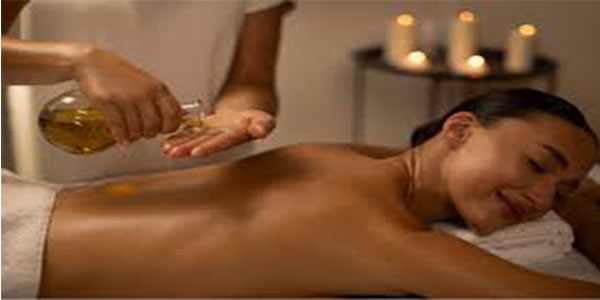
Of course. Here is a comprehensive overview of aromatherapy massage, covering what it is, how it works, its benefits, popular oils, and what to expect during a session.
What is an Aromatherapy Massage?
An aromatherapy massage is a holistic therapy that combines the therapeutic physical touch of massage with the added benefits of highly concentrated plant extracts known as essential oils.
It’s more than just a pleasant scent; it’s a practice aimed at enhancing both physical and emotional well-being by using specific oils chosen for your individual needs.
How It Works: The Two-Fold Approach
The power of an aromatherapy massage comes from two primary mechanisms:
- Absorption through the Skin: During the massage, the essential oils, diluted in a carrier oil (like sweet almond, jojoba, or grapeseed oil), are absorbed through your skin and into your bloodstream. From there, they can travel throughout the body to target specific areas.
- Inhalation (The Olfactory System): As you breathe in the scent of the oils during the massage, the aroma molecules travel up your nose and are detected by nerve cells. These cells send immediate signals to your limbic system—the part of your brain that governs emotions, memories, and hormonal responses. This is why a scent can instantly change your mood or evoke a powerful memory.
The combination of these two actions creates a powerful synergy between body and mind.
Key Benefits
People seek out aromatherapy massage for a wide range of reasons:
- Stress and Anxiety Reduction: This is one of the most common uses. Oils like Lavender, Bergamot, and Frankincense are renowned for their calming and grounding properties.
- Improved Mood and Reduced Depression: Uplifting scents like Sweet Orange, Ylang Ylang, and Grapefruit can help combat low mood and promote feelings of joy.
- Pain Relief and Reduced Muscle Tension: The massage itself works out knots, while anti-inflammatory and analgesic oils like Peppermint, Eucalyptus, and Ginger can enhance pain relief for sore muscles, arthritis, or headaches.
- Boosted Immunity: Some oils, such as Tea Tree, Eucalyptus, and Lemon, have antimicrobial and immune-boosting properties. The massage also stimulates the lymphatic system, which helps remove toxins from the body.
- Improved Sleep Quality: The deeply relaxing nature of the massage, combined with sedative oils like Lavender and Roman Chamomile, can significantly improve the quality of sleep.
- Relief from Respiratory Issues: Eucalyptus and Peppermint oils are excellent decongestants and can help clear sinuses and ease breathing during a chest and back massage.
Popular Essential Oils and Their Uses
A therapist will select a blend based on your consultation. Here are some common examples:
| Essential Oil | Primary Aromatherapy Use |
|---|---|
| Lavender | The ultimate all-rounder. Calming, relieves stress, promotes sleep, and helps heal minor burns and cuts. |
| Peppermint | Invigorating, improves focus, relieves headaches, soothes muscle aches, and aids digestion. |
| Eucalyptus | Clears sinuses and congestion, fights colds, and is a powerful antimicrobial. |
| Tea Tree | A powerful antiseptic, great for acne-prone skin and fighting infections. |
| Roman Chamomile | Deeply calming, anti-inflammatory, and excellent for soothing anxiety and skin irritation. |
| Bergamot | Uplifting and calming—unique for its ability to reduce anxiety while also elevating mood. |
| Rosemary | Stimulates mental clarity, improves memory, and relieves muscle pain. |
| Ylang Ylang | An antidepressant and sedative, known for reducing stress and balancing hormones. |
What to Expect During a Session
- Consultation: Your session will always begin with a conversation. The therapist will ask about your physical and emotional well-being, any medical conditions, allergies, or areas of tension, and what you hope to achieve from the massage (e.g., relaxation, energy, pain relief).
- Oil Selection: Based on your consultation, the therapist will create a custom blend of 2-4 essential oils diluted in a carrier oil.
- The Massage: You will be left alone to undress to your comfort level and lie on the massage table under a sheet. The therapist will use a combination of Swedish massage techniques (long, flowing strokes, kneading) to apply the oil. The pressure can be adjusted to your preference, from light to firm.
- The Environment: The room will typically be quiet, with soft lighting and calming music to enhance the relaxing experience.
- Aftercare: After the massage, the therapist will leave you to get dressed slowly. They will likely advise you to drink plenty of water to help flush out any released toxins and to avoid strenuous activity to prolong the feeling of relaxation.
Important Safety Considerations
- Allergies: Always inform your therapist of any allergies or sensitivities.
- Pregnancy & Medical Conditions: If you are pregnant, breastfeeding, have epilepsy, high blood pressure, or any other serious medical condition, you must inform your therapist and get clearance from your doctor beforehand. Some oils are not safe in these situations (e.g., Rosemary and Peppermint are often avoided during pregnancy).
- Phototoxicity: Some citrus oils (like Bergamot, Lemon, and Grapefruit) can make your skin sensitive to sunlight and cause burns. A professional therapist will be aware of this and may avoid them or use pre-distilled versions.
- Skin Irritation: Essential oils are highly concentrated and must always be diluted in a carrier oil before being applied to the skin. Never apply them neat.
In summary, an aromatherapy massage is a versatile and deeply therapeutic treatment that addresses the needs of both the body and the mind, offering a path to relaxation, healing, and overall well-being.
